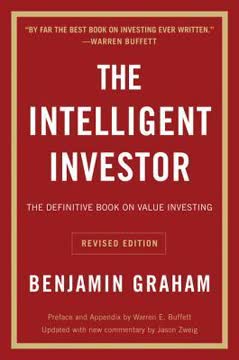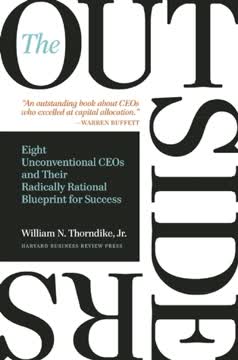Key Takeaways
1. Value creation is driven by return on invested capital and growth
The faster companies can grow their revenues and deploy more capital at attractive rates of return, the more value they create.
ROIC and growth drive value. Return on invested capital (ROIC) and revenue growth are the twin engines of value creation for companies. High ROIC allows companies to generate more cash flow from their existing capital base. Meanwhile, growth enables companies to invest more capital at attractive returns, compounding value over time.
The relative importance of ROIC vs. growth depends on a company's current performance:
- For high-ROIC companies, accelerating growth creates the most additional value
- For low-ROIC companies, improving returns should be prioritized before pursuing growth
Different types of growth create varying amounts of value:
- New products typically create the most value (1.75-2.00x revenue)
- Expanding existing markets is next most valuable (0.30-0.75x)
- Acquiring businesses tends to create the least value (0-0.20x)
2. Conserving value means focusing on increasing cash flows
Anything that doesn't increase cash flows doesn't create value.
Cash flow is king. The conservation of value principle states that financial engineering and accounting manipulations do not create real value - only increasing cash flows does. Many executives fall into the trap of pursuing actions that boost short-term earnings or EPS without actually improving the underlying economics and cash flows of the business.
Common value-destroying pitfalls to avoid:
- Financial engineering like complex debt structures
- Accounting changes that boost reported earnings
- Acquisitions justified by EPS accretion alone
- Repurchasing shares solely to increase EPS
Instead, executives should focus relentlessly on initiatives that genuinely improve cash flows through higher revenues, margins, capital efficiency, or lower costs. This requires discipline to resist short-term pressures and make decisions based on long-term value creation.
3. The expectations treadmill challenges sustained outperformance
No company can perpetually outperform the stock market's expectations.
Expectations rise with performance. As companies deliver strong results, the market's expectations for future performance rise accordingly. This creates an "expectations treadmill" where companies must continually accelerate performance just to keep up with ever-increasing expectations embedded in their stock price.
The expectations treadmill explains several market phenomena:
- High-performing companies can see stagnant stock prices despite continued strong results
- Turnaround situations often see dramatic stock price gains as expectations are reset higher
- Sustained stock outperformance becomes increasingly difficult over time
To navigate this dynamic, executives should:
- Focus on long-term value creation rather than short-term stock moves
- Understand the expectations embedded in their current stock price
- Avoid setting unrealistic expectations that can't be sustained
- Consider relative performance vs. peers rather than absolute stock returns
4. A company's value depends on who owns and manages it
Different owners will generate different cash flows for a given business based on their unique abilities to add value.
The best owner maximizes value. A business has no single inherent value - its value depends on who owns and operates it. The "best owner" of a business is whoever can generate the highest cash flows from it over time. This principle has important implications for corporate strategy and M&A.
Ways owners can add unique value:
- Synergies with other businesses in their portfolio
- Superior operational or functional capabilities
- Better insight into industry trends and opportunities
- Improved governance and incentive structures
- Distinctive relationships with key stakeholders
The best owner for a business changes over time as industries evolve. Executives should:
- Regularly assess whether they remain the best owner of their various business units
- Divest businesses where another owner could create more value
- Acquire businesses where they have a unique ability to improve performance
5. Understanding investor types helps navigate the stock market
The market isn't a monolith, and the interaction of investors creates volatility that isn't necessarily driven by new information.
Different investors drive different behaviors. The stock market comprises diverse investor types with varying strategies, time horizons, and decision-making processes. Understanding this landscape helps executives interpret market movements and focus on the investors who matter most.
Key investor types:
- Intrinsic investors: Focus on long-term fundamental value (20% of assets, 10% of volume)
- Traders: Seek short-term price movements (35% of assets, high volume)
- Mechanical investors: Follow strict formulaic approaches (e.g. indexers)
- Closet indexers: Closely track market indexes despite claiming active management
Intrinsic investors ultimately drive long-term valuation levels, while traders create short-term volatility. Executives should prioritize communication with intrinsic investors who have the greatest impact on sustainable value creation.
6. Stock market performance aligns with real economic factors
Once we factor in the effect of inflation and interest rates, this performance will make sense.
Economic fundamentals drive markets. While short-term stock movements can seem random, long-term market performance aligns closely with real economic factors like GDP growth, corporate profits, inflation, and interest rates. Understanding these relationships helps put market movements in context.
Key drivers of stock market returns:
- Corporate profit growth (real growth of ~3-3.5% annually)
- Dividend/buyback yields (~3-3.5% annually)
- Changes in valuation multiples (driven by interest rates/inflation)
Over the very long term, real stock returns have averaged 6.5-7% annually, closely matching the sum of profit growth and dividend yields. Shorter-term deviations from this trend are often explained by changes in interest rates and inflation impacting valuation multiples.
7. Long-term stock returns reflect fundamental business performance
Adjusted for inflation, large U.S. equities have earned returns to shareholders of about 6.5 to 7 percent annually.
Fundamentals win in the long run. While short-term stock movements can be driven by changing expectations, technical factors, or irrational behavior, long-term returns ultimately reflect the underlying economic performance of businesses. This reinforces the importance of focusing on fundamental value creation.
Components of long-term stock returns:
- Real profit growth: ~3-3.5% annually
- Dividend/buyback yield: ~3-3.5% annually
- Total real return: ~6.5-7% annually
This long-term return is remarkably consistent and can be explained by fundamental economic forces. Significant deviations from this trend are unlikely unless there are radical changes in investor risk preferences or the structure of the economy. Executives should be wary of expectations for sustained returns significantly above this level.
Last updated:
FAQ
What's Value: The Four Cornerstones of Corporate Finance about?
- Core Focus on Value Creation: The book emphasizes creating value for shareholders through effective capital investment and management.
- Four Cornerstones: It introduces four essential principles: the core of value, conservation of value, expectations treadmill, and the best owner.
- Practical Framework: Provides a framework for evaluating business strategies, mergers, acquisitions, and financial policies to ensure alignment with value creation.
- Real-World Applications: Uses examples and case studies to illustrate how companies can manage capital structure, growth, and investor communications effectively.
Why should I read Value: The Four Cornerstones of Corporate Finance?
- Guidance for Executives: Essential for corporate leaders seeking to improve decision-making processes and enhance shareholder value.
- Understanding Market Dynamics: Helps readers understand the relationship between corporate performance and stock market behavior.
- Avoiding Common Mistakes: Equips readers with knowledge to avoid decisions that could erode value.
- Expert Insights: Written by McKinsey & Company experts, drawing on extensive research and industry experience.
What are the key takeaways of Value: The Four Cornerstones of Corporate Finance?
- Value Creation is Paramount: Companies must focus on creating value for shareholders rather than short-term financial targets.
- Importance of ROIC: Return on Invested Capital (ROIC) is critical for assessing a company's efficiency in generating returns.
- Balancing Goals: Executives must balance immediate profits with long-term investments in growth.
- Four Cornerstones Defined: Companies create value by generating cash flows that exceed the cost of capital, among other principles.
What is the core of value as defined in Value: The Four Cornerstones of Corporate Finance?
- Combination of Growth and ROIC: The core of value is the relationship between revenue growth and ROIC.
- Strategic Implications: Companies with high ROIC should focus on growth opportunities, while those with lower ROIC should improve returns first.
- Mathematical Representation: A formula relates a company's value to its growth rate and ROIC, emphasizing their critical role in valuation.
- Real-World Examples: Uses examples like Walgreens and Wrigley to illustrate the impact on shareholder returns.
How does the conservation of value principle work in Value: The Four Cornerstones of Corporate Finance?
- Definition of Conservation: Actions that do not increase cash flows, such as financial engineering, do not create real value.
- Misconceptions Addressed: Many executives mistakenly believe they can create value through financial maneuvers.
- Implications for Decision-Making: Encourages considering the broader impact of decisions on all stakeholders.
- Practical Applications: Crucial for evaluating decisions related to capital structure, share repurchases, and acquisitions.
What is the expectations treadmill concept in Value: The Four Cornerstones of Corporate Finance?
- Definition of Expectations Treadmill: Refers to the pressure on companies to meet or exceed investor expectations continuously.
- Impact on Management Decisions: Can lead to a focus on short-term results at the expense of long-term value creation.
- Volatility in Stock Prices: Companies that meet high expectations may struggle to maintain stock prices.
- Strategies to Overcome: Suggests managing investor expectations while pursuing long-term goals.
What is the significance of identifying the best owner for a business in Value: The Four Cornerstones of Corporate Finance?
- Value Maximization: The best owner can generate the highest cash flows from a business.
- Competitive Advantage: Different owners bring unique advantages, enhancing business performance.
- Dynamic Ownership: The best owner can change over time, requiring regular evaluations of business portfolios.
- Strategic Implications: Ensures optimal ownership structures for maximizing value.
How can companies effectively manage their capital structure according to Value: The Four Cornerstones of Corporate Finance?
- Balancing Debt and Equity: Find the right mix to optimize capital structure, weighing benefits and risks.
- Maintaining Flexibility: Ensure flexibility to pursue growth opportunities and weather economic downturns.
- Regular Assessment: Regularly review and adjust capital structure in response to market conditions.
- Long-Term Sustainability: A balanced approach is crucial for maintaining competitiveness and resilience.
What are the value-creating acquisition archetypes mentioned in Value: The Four Cornerstones of Corporate Finance?
- Improving Target Performance: Acquiring companies to improve operational performance through cost reductions or efficiency gains.
- Consolidation for Capacity Removal: Focuses on consolidating companies to eliminate excess capacity, improving pricing power.
- Accelerating Market Access: Acquisitions to leverage distribution channels and market presence for rapid revenue growth.
- Strategic Growth: Each archetype offers a strategic path to enhance the value of the acquired entity.
How does Value: The Four Cornerstones of Corporate Finance define risk management?
- Categorization of Risks: Risks are categorized into internal, natural disaster, and external economic risks.
- Balancing Risk and Opportunity: Involves mitigating downsides while recognizing opportunities from risk.
- Practical Strategies: Provides strategies for measuring and managing risks effectively.
- Strategic Alignment: Aligns risk-taking with strategic objectives for better performance and value.
What are some common misconceptions in corporate finance discussed in Value: The Four Cornerstones of Corporate Finance?
- Leverage Misunderstandings: Increasing leverage is often mistakenly believed to create value.
- Earnings Management Fallacies: Managing earnings to meet short-term targets can lead to long-term value destruction.
- Market Misinterpretations: Stock prices are driven by investor expectations, not just earnings.
- Strategic Clarity: Understanding these misconceptions helps avoid decisions that erode value.
What are the best quotes from Value: The Four Cornerstones of Corporate Finance and what do they mean?
- "Value creation is the primary goal of any business strategy.": Emphasizes aligning corporate actions with enhancing shareholder value.
- "The expectations treadmill can lead to a focus on short-term results.": Highlights the pressure to meet investor expectations, detracting from long-term planning.
- "Debt is a double-edged sword.": Illustrates the complexities of using debt, enhancing returns but increasing risk.
- Strategic Insights: Each quote encapsulates key themes and strategic insights from the book.
Review Summary
Value is highly regarded for its comprehensive overview of corporate finance and valuation principles. Readers appreciate its clear explanations of complex concepts, including growth, ROIC, and shareholder value creation. The book debunks common misconceptions and offers practical insights for executives and investors alike. While some find it challenging or dry, many consider it an essential read for financial professionals. The book's focus on long-term value creation and its analysis of various corporate strategies are particularly praised. However, a few readers note that the content may be less applicable to small businesses.
Similar Books










Download PDF
Download EPUB
.epub digital book format is ideal for reading ebooks on phones, tablets, and e-readers.




